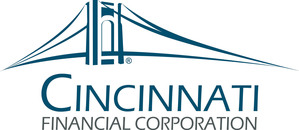CINCINNATI, Sept. 24, 2012 /PRNewswire/ -- Cincinnati Financial Corporation (Nasdaq: CINF) today announced that Jacob F. Scherer, executive vice president of The Cincinnati Insurance Company since 2008, now is also chief insurance officer. His executive oversight responsibility for the insurance subsidiaries is expanded to include personal lines and reinsurance in addition to business insurance. The company is consolidating under Scherer the responsibility for strategic oversight of multiple departments handling property casualty insurance sales, marketing, underwriting and related field services.
(Logo: http://photos.prnewswire.com/prnh/20110824/CL57087LOGO )
Scherer's 28 years with Cincinnati and 38 years of service in the insurance industry include experience in sales and agency relationship management, field marketing and underwriting, life insurance marketing, agency perpetuation planning and management of a family-owned independent insurance agency.
The company also announced that Thomas A. Joseph, CPCU, is leaving the company today after 35 years of service. Joseph was senior vice president in charge of personal lines operations for The Cincinnati Insurance Company and president of The Cincinnati Casualty Company since 2008.
Steven J. Johnston, president and chief executive officer, commented, "We thank Tom for his willingness over the years to take on many challenging assignments in areas from claims to information systems, commercial lines and personal lines. In recent years, he also has managed our highly effective catastrophe, treaty and facultative reinsurance programs.
"Naming a chief insurance officer unites our team of leaders responsible for profitable growth of our commercial, personal and excess and surplus lines insurance business. JF is a proven champion for our independent insurance agency customers and the field representatives who serve those agencies and their clients locally. He has brought people together to drive significant improvements across our business insurance operations. I believe he will replicate this success in his expanded role, increasing collaboration to drive achievement of our shared goals."
Cincinnati Financial Corporation offers business, home and auto insurance, our main business, through The Cincinnati Insurance Company and its two standard market property casualty companies. The same local independent insurance agencies that market those policies may offer products of our other subsidiaries, including life and disability income insurance, annuities and surplus lines property and casualty insurance. For additional information about the company, please visit www.cinfin.com.
| Mailing Address: |
Street Address: |
| P.O. Box 145496 |
6200 South Gilmore Road |
| Cincinnati, Ohio 45250-5496 |
Fairfield, Ohio 45014-5141 |
Safe Harbor
This is our "Safe Harbor" statement under the Private Securities Litigation Reform Act of 1995. Our business is subject to certain risks and uncertainties that may cause actual results to differ materially from those suggested by the forward-looking statements in this report. Some of those risks and uncertainties are discussed in our 2011 Annual Report on Form 10-K, Item 1A, Risk Factors, Page 26.
Factors that could cause or contribute to such differences include, but are not limited to:
- Unusually high levels of catastrophe losses due to risk concentrations, changes in weather patterns, environmental events, terrorism incidents or other causes
- Increased frequency and/or severity of claims
- Inadequate estimates or assumptions used for critical accounting estimates
- Recession or other economic conditions resulting in lower demand for insurance products or increased payment delinquencies
- Declines in overall stock market values negatively affecting the company's equity portfolio and book value
- Events resulting in capital market or credit market uncertainty, followed by prolonged periods of economic instability or recession, that lead to:
- Significant or prolonged decline in the value of a particular security or group of securities and impairment of the asset(s)
- Significant decline in investment income due to reduced or eliminated dividend payouts from a particular security or group of securities
- Significant rise in losses from surety and director and officer policies written for financial institutions or other insured entities
- Prolonged low interest rate environment or other factors that limit the company's ability to generate growth in investment income or interest rate fluctuations that result in declining values of fixed-maturity investments, including declines in accounts in which we hold bank-owned life insurance contract assets
- Increased competition that could result in a significant reduction in the company's premium volume
- Delays or performance inadequacies from ongoing development and implementation of underwriting and pricing methods or technology projects and enhancements expected to increase our pricing accuracy, underwriting profit and competitiveness
- Changing consumer insurance-buying habits and consolidation of independent insurance agencies that could alter our competitive advantages
- Inability to obtain adequate reinsurance on acceptable terms, amount of reinsurance purchased, financial strength of reinsurers and the potential for non-payment or delay in payment by reinsurers
- Difficulties with technology or data security breaches, including cyber attacks, that could negatively affect our ability to conduct business and our relationships with agents, policyholders and others
- Inability to defer policy acquisition costs for any business segment if pricing and loss trends would lead management to conclude that segment could not achieve sustainable profitability
- Events or conditions that could weaken or harm the company's relationships with its independent agencies and hamper opportunities to add new agencies, resulting in limitations on the company's opportunities for growth, such as:
- Downgrades of the company's financial strength ratings
- Concerns that doing business with the company is too difficult
- Perceptions that the company's level of service, particularly claims service, is no longer a distinguishing characteristic in the marketplace
- Actions of insurance departments, state attorneys general or other regulatory agencies, including a change to a federal system of regulation from a state-based system, that:
- Impose new obligations on us that increase our expenses or change the assumptions underlying our critical accounting estimates
- Place the insurance industry under greater regulatory scrutiny or result in new statutes, rules and regulations
- Restrict our ability to exit or reduce writings of unprofitable coverages or lines of business
- Add assessments for guaranty funds, other insurance related assessments or mandatory reinsurance arrangements; or that impair our ability to recover such assessments through future surcharges or other rate changes
- Increase our provision for federal income taxes due to changes in tax law
- Increase our other expenses
- Limit our ability to set fair, adequate and reasonable rates
- Place us at a disadvantage in the marketplace
- Restrict our ability to execute our business model, including the way we compensate agents
- Adverse outcomes from litigation or administrative proceedings
- Events or actions, including unauthorized intentional circumvention of controls, that reduce the company's future ability to maintain effective internal control over financial reporting under the Sarbanes-Oxley Act of 2002
- Unforeseen departure of certain executive officers or other key employees due to retirement, health or other causes that could interrupt progress toward important strategic goals or diminish the effectiveness of certain longstanding relationships with insurance agents and others
- Events, such as an epidemic, natural catastrophe or terrorism, that could hamper our ability to assemble our workforce at our headquarters location
Further, the company's insurance businesses are subject to the effects of changing social, economic and regulatory environments. Public and regulatory initiatives have included efforts to adversely influence and restrict premium rates, restrict the ability to cancel policies, impose underwriting standards and expand overall regulation. The company also is subject to public and regulatory initiatives that can affect the market value for its common stock, such as measures affecting corporate financial reporting and governance. The ultimate changes and eventual effects, if any, of these initiatives are uncertain.
SOURCE Cincinnati Financial Corporation
WANT YOUR COMPANY'S NEWS FEATURED ON PRNEWSWIRE.COM?
Newsrooms &
Influencers
Digital Media
Outlets
Journalists
Opted In




Share this article